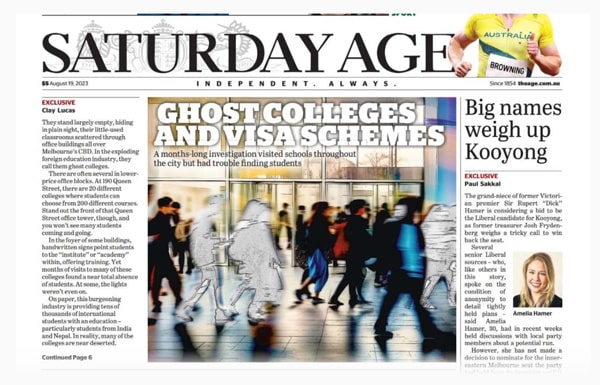Under pressure: Changing markets and the evolution of the university
We have all read the worrying proclamations about the challenges facing traditional higher education, and even questions about the sustainability of at least some institutions today. Many experts predict that few colleges or universities can face the following trends without a fundamental rethinking of the way they operate:
- Demographics are changing: The population of college-age students is shrinking in a number of countries, including Canada, South Korea, Japan, and Taiwan.
- Markets are shifting: The distinction between "source" and "destination" countries continues to blur to the extent that traditional large source countries such as China cannot be relied upon as a continued base of highly valued international student tuition.
- Online is expanding: MOOCs and other digital-based delivery models - as well as diploma/certificate programmes and alternative credentials - are throwing the cost and time required for four-year university degrees into high relief.
- Private sector schools are competing: Younger private institutions are challenging their public-sector fellows on all sorts of measures, including price, specialisation, and, especially in developing countries, quality alternatives to overburdened public systems. Add to this a perceived disconnect between higher education and the job market, plus heightened price sensitivity among some student segments, and it is clear that universities and colleges are being challenged to adapt - and fast.
University evolution 2.0
But while higher education institutions are indeed facing pressures on established operating and business models, some are overcoming them using new approaches to programme design, target markets, and funding, as well as branding and marketing campaigns that emphasise their institutions’ strengths more effectively than ever. Eric Beerkens, writing in University World News, says that "the DNA of the traditional university has not changed in the past 25 years and I can safely predict that it will not change in the coming 25 years. And essentially, that is a good thing." He pairs this observation with an argument that the traditional university model has never been static and has been evolving for years in response to internal and external demands. Indeed, around the world, there is evidence that universities and colleges are responding to today’s challenges in unique and innovative ways. Here are just a few examples: 1. Developing a niche: One strategy for universities is to abandon what they are merely average at, focus on their strengths, and roll out targeted marketing campaigns to niche markets. An example of a highly focused institution is the College of the Atlantic (COA) in Maine. COA was the first US college to go carbon-neutral, and among its many environmental features are its eight student residences with composting toilets and grey-water recycling to minimise water use. COA has also responded quickly to the growing demand for international exposure and internships: more than half of COA students include international study in their curriculum, and 100% complete an internship as part of their degree. 2. Encouraging entrepreneurship: Economies everywhere are bursting out of traditional hierarchies in which "big" equalled "great." Startups have proliferated, and today many college students aspire to be their own bosses. As a result, there is a growing trend toward fostering entrepreneurship in higher education. For example, the Technion - The Israel Institute of Technology - offers a month-long summer intensive programme for entrepreneurs. The Technion Entrepreneurship and Innovation Summer School is "for tech minded students seeking to develop ideas into a start-up or work in an entrepreneurial environment in fields like software, big data, cyber world, online media and related areas." The school is one of many initiatives that link the Technion to entrepreneurs and other partners in industry, including start-up incubators or accelerators. The noted Israeli institution has been ranked among the leading universities in the world for entrepreneurship and innovation in a multi-year benchmarking study conducted by MIT. 3. Investing in internationalisation: A big part of the Russian government’s strategy to move five of its universities into the Top 100 world university rankings is providing new academic mobility grants to bring elite foreign researchers into Russian classrooms. Russia is far from the only country pushing inter-institutional mobility; collaborative cross-border research projects and faculty exchanges abound in higher education today. Where universities don’t have the researchers and faculty they need locally, they find them in other countries and promote "star" lecturers to draw students to courses. 4. Collaborating across countries: What’s better than a top-ranked research university? Two top-ranked research universities - one Chinese, one American - collaborating on one incredible venture. Earlier this year, the University of Washington and China’s Tsinghua University announced a joint project called the Global Innovation Exchange (GIX), a brand-new facility focusing on science and technology studies in Seattle, Washington. The Microsoft-backed GIX will be the first time a Chinese research university will offer a degree in the US. 5. Thinking differently about money: In the US especially (in part because of reduced public funding), colleges and universities are seeking non-traditional methods to raise revenue, including developing new, niche student markets; offering classes on weekends or during summer months to appeal to part-time and non-traditional demographics; and of course, recruiting international students. And in markets across the globe, private funding and participation is quietly growing, even in areas traditionally thought of as completely public. 6. Experimenting with technology: Gone are the predictions that MOOCs will simply displace all other educational delivery models. Online-only programmes certainly exist, but increasingly, institutions are bringing in technologies to leverage or strengthen core competencies - and to push down costs. Blended or hybrid degrees abound; universities are offering MOOCs as well as courses delivered on campus. Professors are incorporating real-time analytics information to better personalise students’ learning, and institutions are discovering what works online and what is best kept in the physical classroom. 7. Using beauty-based branding: Not all students are lured by the novelty of MOOCs and other online programmes. For many international students, the physical experience of studying in another country remains their top priority, and this includes accommodations, learning facilities, and the wider environment and recreational opportunities available to them. Top-ranked universities are making their campuses more state-of-the art, and destination marketing is a noteworthy trend, especially in countries and regions known for extreme natural beauty. New Zealand’s Think New campaign is one example of top-notch destination marketing, while universities in Málaga, Spain are leveraging their beautiful historic city. Destination marketing can offer a powerful competitive advantage for universities and regions outside of the traditional consideration set of international students.
Higher education in 2016
There is no turning back from the disruptions affecting higher education today; they have occurred, and they will continue to unfold in the years ahead. Some institutions will falter, but many will reach farther and faster than they have before. The most resilient will be adaptable shape-shifters and strategists conditioned to the new constant: change.













